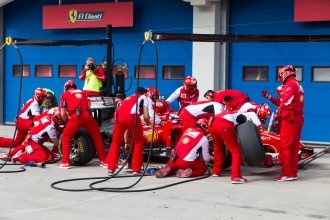How a F1 pit stop shows us where teamwork doesn’t work
Every now and again an article crops up praising the pit crew who change the tyres and refuel Formula One cars during the race as the epitome of teamwork and communication. Of course it’s nothing of the sort; it actually shows us that if we want to get something done really quickly teams can be a problem.
If you look at how a pit crew operates they have a very tight timescale and a very clear shared goal but it isn’t a collaborative goal it’s more about coordinating the effort of individuals or sub- groups of 2-3 people.
A team is where individuals with different complimentary skills come together and work intensively together to create a collaborative outcome. In teams the outcome is more than the sums of the parts of the individual effort.
Formula One pit crews are actually groups, a group is a hub and spoke way of working where individuals each have their own unique contribution but they are coordinated at some level.
If you watch a pit crew in action there are individuals who jack up the front of the car, clean vents or wash the screen. There are several pairs or triads who, working independently from the other pairs, change a wheel or refuel the car. Each of these individuals or pairs signals to the person at the front of the car when they are finished and that individual that makes the decision to release the car.
Even within the group of three people responsible for changing a tyre, each one has completely independent sets of tasks and only focuses on those tasks.
It is incredibly well coordinated, but it’s not teamwork. It is a number of individuals or small groups doing their jobs. Coordination is linear from these people to one individual – and is often limited to a hand signal. The activities of these individuals or pairs are not coordinated amongst each other. The person changing the left front wheel doesn’t collaborate with the person changing the back right or filling the fuel.
Imagine if all 20 or so members of the pit stop crew really had to communicate with every other individual and collaborate, there is certainly no time to focus on what other people are doing in a 2 second pit stop.
The reason I feel strongly enough about this to bother writing a blog is that this confusion about modes of collaboration is very common in large organizations. They tend to call everything “teamwork” and teamwork implies that every individual is connected with and interdependent with every other individual in the team. This leads to a proliferation of meetings and information sharing that is often unnecessary to the performance of the job.
If you sit in a “team meeting” where you spend hours listening to boring and irrelevant updates about what other people were doing last week then you are probably part of a group – if you are part of the team you would need to know what these individuals are doing in order to do your job because teams are defined by their interdependence.
Understanding this and preferring to use group mode for many activities can make a huge positive impact on the performance of the team, particularly one that is not co-located and has to work together through technology and across time zones. This much simpler way of working is much easier to organize in a complex environment.
That is not to say that you have to make a choice to either be a team or group once and forever, the skill is in understanding which mode you are in and preferring to use group mode wherever you can. There will still be times when you need to operate as a team and truly collaborate, but my bet is that they won’t be as often as you think.
At one of our global team meetings some years ago we did a motorsport day. We loved the driving but when we were offered the opportunity to do a “team exercise” of acting as a pit crew we surprised our hosts with virtually all of our consultants saying at the same time “it’s not a team activity – it’s a group”.
So individuals focusing only on their own work and communicating only with hand signals is surely not the epitome of teamwork and communication – but it can teach us some important lessons on how much quicker it is to get things done in a group.
Check out our insights on new ways of working.

Explore our training programs to see how we can help.
Agile & Digital Training Matrix Management Training People and purpose Training Virtual Teams TrainingEducate yourself further with a few more or our online insights:
30 years of experience learning with a range of world class clients
We work with a wide range of clients from global multinationals to recent start-ups. Our audiences span all levels, from CEOs to operational teams around the world. Our tools and programs have been developed for diverse and demanding audiences.

Tailored training or off the shelf modules for your people development needs
We are deep content experts in remote, virtual and hybrid working, matrix management and agile & digital leadership. We are highly flexible in how we deliver our content and ideas. We can tailor content closely to your specific needs or deliver off the shelf bite sized modules based on our existing IP and 30 years of training experience.
For more about how we deliver our keynotes, workshops, live web seminars and online learning.